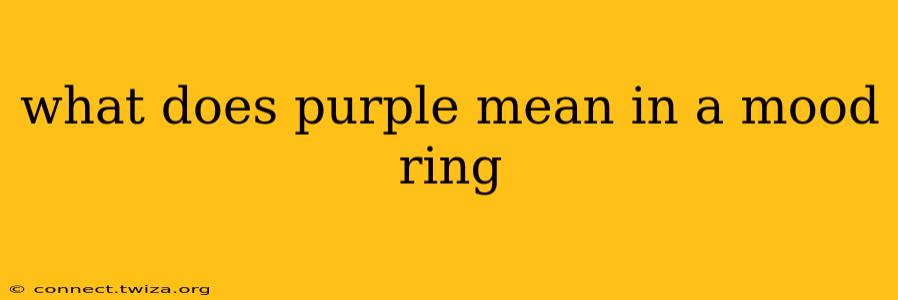What Does Purple Mean in a Mood Ring? Decoding the Colors of Emotion
Mood rings, those fascinating pieces of jewelry that supposedly reflect your emotional state through color changes, have captivated people for decades. While the science behind their accuracy is debated, the captivating interplay of colors and their associated meanings continues to intrigue. One of the most frequently asked questions is: what does purple mean in a mood ring?
Let's delve into the interpretation of purple and explore other common mood ring colors and their purported meanings.
What Does Purple Mean in a Mood Ring?
Generally, purple in a mood ring is associated with independence and creativity. It suggests a state of calm, self-assuredness, and a comfortable connection with oneself. The wearer might feel confident, in control, and content with their current emotional state. This isn't necessarily a high-energy excitement; rather, it represents a peaceful yet strong sense of self. Think of it as the quiet confidence of a seasoned artist preparing for their next masterpiece or the calm determination of an entrepreneur on the verge of a breakthrough.
It's crucial to remember that the interpretation of colors in a mood ring is subjective and based on a generalized color psychology rather than a scientifically proven method. What purple means to one person might differ slightly from another's interpretation.
What Other Colors Are There and What Do They Mean?
Mood rings typically display a range of colors, each allegedly reflecting a different emotional state. While the exact shades and their interpretations can vary slightly between manufacturers, here's a common color guide:
-
Black: Often associated with stress, tension, or even illness. It might indicate a need for rest and relaxation.
-
Dark Blue/Indigo: Can signify sadness, depression, or feelings of insecurity.
-
Blue: Represents a calmer, more relaxed state, possibly indicating contentment or peacefulness.
-
Green: Usually associated with balance and harmony, a sense of well-being, and emotional stability.
-
Yellow/Gold: Represents excitement, happiness, or a generally positive and energetic mood.
-
Orange: Can symbolize enthusiasm, sociability, and a high level of energy.
-
Red: Frequently linked to feelings of anger, passion, or excitement; sometimes even stress.
-
Violet/Purple (as discussed above): Indicates independence, creativity, and a comfortable, self-assured state.
Are Mood Rings Accurate?
The scientific community largely disputes the accuracy of mood rings. Their color changes are primarily caused by thermochromic liquid crystals reacting to skin temperature. While your skin temperature can fluctuate slightly based on factors like stress or excitement, it’s not a direct or precise measure of complex emotions. Essentially, a mood ring is more of a fun novelty item than a reliable emotional barometer.
How Does a Mood Ring Work?
The color-changing effect is due to thermochromic liquid crystals embedded within the stone of the ring. These crystals change color based on subtle shifts in temperature. Since body temperature can vary based on internal states, including emotions, it gives the illusion of the ring reflecting one's mood. However, the connection between temperature fluctuations and complex emotional states isn't directly correlated.
Why Do Mood Ring Colors Change So Quickly?
The rapid color shifts are often due to the sensitivity of the thermochromic liquid crystals within the ring. Small temperature changes from contact with your skin or ambient air temperature can trigger rapid color transitions, making the reading appear more erratic than a precise reflection of emotion. Also, the age and condition of the mood ring can affect its responsiveness.
Mood rings remain a fascinating and fun fashion accessory. While their accuracy as emotional indicators is debatable, the mystery and symbolic interpretations surrounding the colors, especially the meaning of purple in a mood ring, continue to pique our curiosity.
